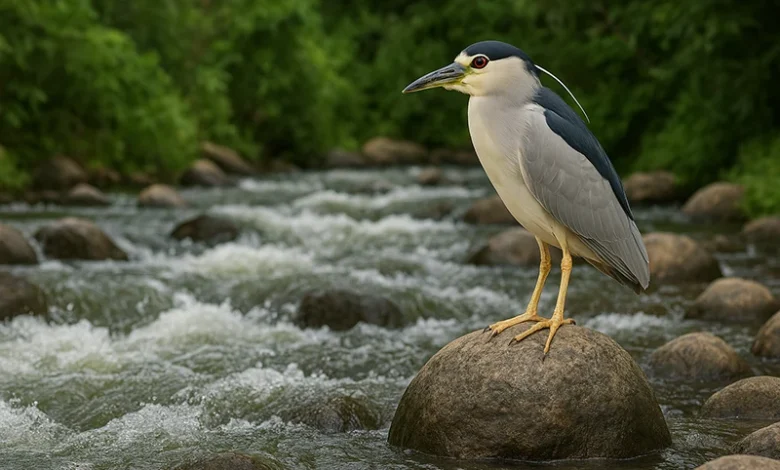Black-crowned Night Heron

The Black-crowned Night Heron (Nycticorax nycticorax) is a secretive, stocky wader known for its dusk-to-dawn activity and striking appearance. In Dominica, it is a rare but notable visitor, usually spotted in wetland margins, mangroves, and quiet riverbanks. While it is not as widespread as the Green Heron or Yellow-crowned Night Heron on the island, occasional sightings confirm its presence—particularly in well-vegetated aquatic habitats.
Appearance and Identification
This heron is short and stout compared to other species, measuring about 64 cm (25 inches) in length. Adults have a black cap and back, gray wings and tail, and white to pale gray underparts. Its red eyes are one of its most distinctive features, adapted for low-light vision. In breeding plumage, two thin white plumes extend from the back of the head. Juveniles are brown with white streaks and spots, resembling immature Yellow-crowned Night Herons but stockier.
Habitat and Distribution in Dominica
Though considered rare on the island, the Black-crowned Night Heron has been observed in the following areas:
- Indian River mangroves (Portsmouth) – Known for low, overhanging branches and shadowy water edges.
- Cabrits National Park – Especially in quiet backwaters near mangrove stands.
- Layou River mouth – Possible during low tide when hunting crustaceans and fish.
- Rosalie estuary and coastal wetlands – Dense vegetation offers the seclusion it prefers.
Due to its nocturnal and crepuscular habits, it’s often overlooked by casual birders but may be spotted at dawn or dusk near still waters.
Behavior and Birdwatching Tips
The Black-crowned Night Heron feeds on fish, frogs, crustaceans, aquatic insects, and occasionally small mammals. It typically stands still at the water’s edge, waiting to ambush prey with a sudden jab of its short, thick bill. During the day, it roosts quietly in dense trees, often with little movement.
Birdwatching tips:
- Visit near sunset or sunrise for best chances of seeing it active.
- Check shaded mangrove edges or low branches over water.
- Use binoculars and be patient—this species prefers stillness and darkness.
- Note the chunky build and pale belly compared to slimmer, more active herons.
Nesting and Conservation
While no large breeding colonies have been confirmed in Dominica, the species is known to nest in dense trees over water, often alongside other herons in mixed colonies. Nests are built from sticks, and 3–5 eggs are typical. While globally secure, this heron depends on healthy wetlands, which remain limited in size across Dominica.
The Black-crowned Night Heron adds mystery and richness to Dominica’s bird diversity. It may be harder to find, but for patient birdwatchers, encountering one is a special reward.




